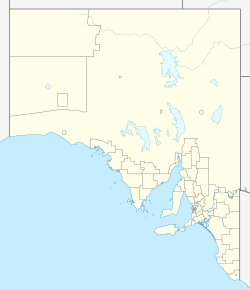Haystack Island facts for kids
| Geography | |
|---|---|
| Location | Investigator Strait |
| Coordinates | 35°19′19″S 136°54′26″E / 35.32191°S 136.9071°E |
| Length | 500 m (1,600 ft) |
| Width | 120 m (390 ft) |
| Highest elevation | 43 m (141 ft) |
| Administration | |
|
Australia
|
|
Haystack Island is a unique island located in Investigator Strait, off the coast of South Australia. It's about 6 kilometers (almost 4 miles) southwest of Stenhouse Bay. This special island has been part of the Althorpe Islands Conservation Park since 1972, helping to protect its natural beauty and wildlife.
Contents
What is Haystack Island Like?
Haystack Island is truly one-of-a-kind. It looks like a tall, narrow wall made of steep cliffs. Over time, the ocean has carved out parts of the island, creating deep indents and even rockfalls. Imagine a series of tall, rounded sections connected by very thin strips of rock, some as narrow as a knife's edge!
The island is surrounded by a reef that has been shaped by waves. Haystack Island is about 500 meters (about 1,640 feet) long. At its widest point, it's about 120 meters (about 390 feet) across. The tallest part of the island reaches a height of 43 meters (about 141 feet). It stretches from the northwest to the southeast.
Reaching the island can be tricky. It's best to visit when the sea is calm. You can get to the top ridge from the east coast. There's a slope made of loose rocks, so climbers need to be very careful. In 1982, a government team even used a helicopter to land on the island's highest point!
Haystack Island is often grouped with the Althorpe Islands and Seal Island. Together, they are known as the Althorpe Islands Group.
How Haystack Island Was Formed
Haystack Island was created around 7,350 years ago. This happened when sea levels rose at the start of the Holocene period. The rising water separated what is now Yorke Peninsula from Kangaroo Island, leaving Haystack Island standing alone.
The island is made of a type of rock called Bridgewater Formation calcarenite. This rock sits on top of a larger, mostly underwater ridge of Gleesons Landing Granite. The island rises from a depth of about 20 meters (about 65 feet) in the ocean. This deep water is very close to its southern shore, within 300 meters (about 980 feet).
Plants and Animals of Haystack Island
Haystack Island is home to various plants and animals, despite its rugged appearance.
Island Plants
In November 1982, experts studied the plants on Haystack Island. They found 11 different kinds of plants growing there. These plants form a type of shrubland along the island's ridge.
- In areas with deeper soil, you can find plants like Grey Samphire, Marsh saltbush, and Nitre-bush.
- In shallower, rockier soils, plants like Cushion-bush, Round-leaved Pigface, and Southern Sea-heath thrive.
Island Animals and Their Life Cycle
The same 1982 survey also found signs of different vertebrate animals living on the island.
- White-faced Storm Petrels: These seabirds use the island for breeding during the summer. The survey found shallow burrows, which are small tunnels they dig for their nests.
- Pacific Gulls: These gulls use the island as a feeding spot. A large pile of shell fragments was found on the highest dome, showing where they had eaten their meals.
- White-bellied Sea Eagles: A well-kept nest was found, indicating that these large birds of prey also live and raise their young on Haystack Island.
Protecting Haystack Island
Haystack Island has special protection to keep its unique environment safe.
- Since 1972, it has been part of the Althorpe Islands Conservation Park. This means the island's nature is protected.
- Since 2007, it has been a "prohibited area." This means you need a special permit to visit the island. This rule helps protect the seabirds that breed there.
- Since 2012, the waters around Haystack Island are part of a "habitat protection zone." This zone is within the Southern Spencer Gulf Marine Park. It helps protect the marine life and habitats in the ocean surrounding the island.


